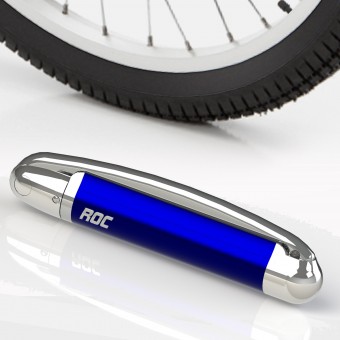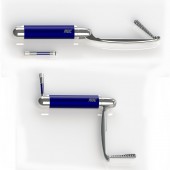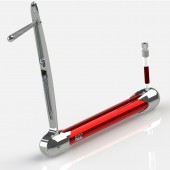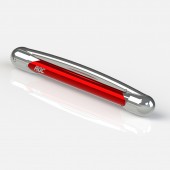
| THE AWARD |
| CATEGORIES |
| REGISTRATION |
| SUBMIT YOUR WORK |
| ENTRY INSTRUCTIONS |
| TERMS & CONDITIONS |
| PUBLICATIONS |
| DATES & FEES |
| METHODOLOGY |
| CONTACT |
| WINNERS |
| PRESS ROOM |
| GET INVOLVED |
| DESIGN PRIZE |
| DESIGN STORE |
| THE AWARD | JURY | CATEGORIES | REGISTRATION | PRESS | WINNERS | PUBLICATIONS | ENTRY INSTRUCTIONS |
Roc Rotary Compact Cycle Pump by Gareth Bristow |
Home > Winners > Design #26589 >Interview |
 |
|
FS: What is the main principle, idea and inspiration behind your design?
GB: At the core of the ROC is a recently patented mechanism that converts rotational action into multiple linear movements. During the design development of the mechanism numerous applications and potential uses including fluid and air displacement, mechanized actuators and gate valves were identified. Due to the simplicity and the anticipated low production costs of the mechanism, it was determined that it could be initially utilised to ideally create a compact and highly efficient hand pump. The internal function and the cranked means by which the pumping action is driven defined the external form of the pump, resulting in an opportunity to create a truly unique hand pump design.
FS: What has been your main focus in designing this work? Especially what did you want to achieve?
GB: Pumped Ltd aim was to develop the new technology for commercial uses and to initially create a pioneering range of rotary cycle pumps with a number of innovative features:- • smaller hand pumps with large pumped volumes, giving quicker inflation times • better ergonomics making tyre inflation easier and less chance of breaking valve stems • focus on design and use of high end materials making the pump a desirable object to own and use.
FS: What are your future plans for this award winning design?
GB: Pumped plan to refine the mechanism to increase the volume displacement potential and it is anticipated that those improvements will be used to design even smaller hand pumps with greater efficiency. In addition to the range of hand pumps, Pumped are currently developing concepts and designs to employ the mechanism in a unique range of electrically driven hand pumps, ball inflation devices, irrigation pumps and are closely looking at utilising the core pumping technologies for other leisure sectors including marine.
FS: How long did it take you to design this particular concept?
GB: Design of the various reiterations of the mechanism started in 2006, resulting in several patent applications between 2007 and 2012, with patents granted in Europe, the US and pending in the Far East. The base design of the ROC hand pump started in 2010 and has evolved over the last two years to incorporate the improved design of the internal mechanism into the current ROC design.
FS: Why did you design this particular concept? Was this design commissioned or did you decide to pursuit an inspiration?
GB: The idea for the initial mechanism derived from a few abstract thoughts relating to how a simple device, such as an actuator, could be designed to achieve a trebling its initial inert length with minimal rotational activation. A search was then undertaken to ensure that no prior art for the mechanical design existed. After a favourable patent search the early designs were then refined and improved to provide the basis of several granted patents. At an early concept stage it was concluded that the mechanism could be manipulated to produce several linear actions for a single rotation of 360 degrees and that this ability was entirely suited to pumping applications or operations requiring efficient pistons. With numerous markets and industrial sectors that would benefit from such a highly efficient and compact pump, it was decided that Pumped Ltd’s initial focus would be on a segment of the leisure market they know very well. Drawing upon their years of experience as cycling enthusiasts, Philip and Gareth were only too aware of the time and effort that is required to inflate a cycle tyre even with the best hand pumps presently on the market. Currently the top selling small pumps require at least 8 pumping actions to achieve 1 psi of pressure and the worst requiring 20 or more pumping actions. With a mountain bike tyre requiring a pressure of 50 psi, it can take considerable time and effort to inflate a tire. Preliminary modelling and analysis of the new pump demonstrated that a pump utilising the new technology could halve the current time it takes to inflate tyres. To support their initial ideas for a more efficient hand pump, there were discussions with several retailers and distributers which indentified a clear potential for a range of compact cycle pumps that are smaller and deliver an increased volume displacement, that result in far quicker inflation times than those presently on the market.
FS: Is your design being produced or used by another company, or do you plan to sell or lease the production rights or do you intent to produce your work yourself?
GB: Pumped Ltd is primarily a design and distribution company and is presently seeking a manufacturing and assembly partner to produce the ROC hand pump in the UK or Europe. Pumped intend to licence the design and trademark once the design is fully optimized and a market has been established for the innovative range of ROC hand pumps.
FS: What made you design this particular type of work?
GB: The design process has been organic, with the internal mechanism and how it is operated symbiotically generating the external aesthetic look of the ROC hand pump.
FS: Where there any other designs and/or designers that helped the influence the design of your work?
GB: The design for the ROC has not been directly influenced by any particular designer or product; however designers like the Joseph Brothers, James Dyson, Henrik Fisker, Philippe Starck and Mies van der Rohe have greatly influenced the way we approach our designs. Aesthetics play a very strong part in our design processes; we aim to produce highly functional products that have great visual appeal.
FS: Who is the target customer for his design?
GB: The cycle pump is an established market. It is estimated that in the UK 3.1 million pumps were sold in 2010. An estimate of the European cycle pump market is 17 million pumps p.a. It is likely that the worldwide cycle pump market is in excess of 100 million units p.a. Overall the market for pumps would appear to be static, although certain sectors within the overall cycle market are currently growing; particularly for premium and children's bikes. The initial target market will be the enthusiast/ commuter cyclist for whom cycling is a major part of their leisure time. The individuals within this sector are willing to purchase cycling items that offer better performance and design. Further market research has indicated that the early adopters for this technology fall with the MAMIL (Middle Aged Men In Lycra) group. Those are medium to high earners that are committed and enthusiastic cyclists that spend considerable amounts on bike frames, wheels and accessories and are very design literate.
FS: What sets this design apart from other similar or resembling concepts?
GB: Uniquely the ROC is rotary operated with a folding crank and represents a landmark in hand pump design. The core technology allows for smaller hand pumps with large pumped volumes, giving quicker inflation times.
FS: How did you come up with the name for this design? What does it mean?
GB: The name for the product range of ROC hand pumps is derived from the description of the internal mechanism:- Reciprocating Oscillating Coupling.
FS: Which design tools did you use when you were working on this project?
GB: The early designs and concepts for the discs and mechanism were sketched by hand and then transferred to AutoCAD for scaled detailing. 3D drawing and dynamic analysis of the designs were then undertaken in Solid Works. This enabled the designs to be printed in 3D and assembled to check functionality. Initial design work for the external form of the pump and crank components were sketched in Photoshop using a digital tablet. The concepts were then worked up to production drawing level and also rendered in Solid Works. 3D printing has been extensively used to develop the designs of the mechanism and pump external components. The company purchased a Denford UP 3D printer to produce the first prototypes and this proved invaluable for testing the ergonomics during the early design stages.
FS: What is the most unique aspect of your design?
GB: The efficient compact design and unique rotary action with a folding crank, will introduce a revolutionary hand pump into a rather technologically stagnant hand pump market.
FS: Who did you collaborate with for this design? Did you work with people with technical / specialized skills?
GB: All of the design work to date has been undertaken in-house by Green Shere Design Ltd, a sister company of pumped Ltd. Product manufacturing advice, optimisation of the Reciprocating Oscillating Coupling and auditing of the components has been undertaken by MAS (Manufacturing Advisory Service, UK), with further analysis and optimisation of the mechanism due to be undertaken by the University of the West of England, with additional prototyping to be taken on by CALM (The Centre for Additive Layer Manufacturing) at Exeter University.
FS: What is the role of technology in this particular design?
GB: The development of a new mechanical device has been fundamental to the efficient pumping qualities of the innovative ROC compact hand pump.
FS: Is your design influenced by data or analytical research in any way? What kind of research did you conduct for making this design?
GB: Full market research, ergonomic studies and extensive volume analysis was undertaken to examine the existing technology utilised within cycle hand pumps currently available on the market. This was commenced prior to the development of the ROC hand Pump to ascertain the potential product position opportunities and identify target markets. This involved obtaining statistical information, communicating with national and international distributers, end users and UK government agencies. Existing cycle pump designs were also scrutinised for form, function, quality of materials and air displacement to determine the effectiveness of existing pumps and which particular design cues and functionality currently appeals to end users within ROCs anticipated strategic market. With this information pumped were able to develop a design brief and the specification criteria required to generate an appealing design.
FS: What are some of the challenges you faced during the design/realization of your concept?
GB: The processes and skills that are necessary to negotiate the hurdles to obtain patents required a particularly steep learning curve.
FS: How did you decide to submit your design to an international design competition?
GB: The extremely positive feedback that pumped has recently received for the ROC from design engineers, marketing professionals, prospective investors and potential end users, suggested that the ROC could be worthy of an design award.
FS: What did you learn or how did you improve yourself during the designing of this work?
GB: The design process required that an entire new range of skills need to be learned including the mastering of 3D engineering and accounting software, preparation of business plans and honing of presentation skills.
FS: Thank you for providing us with this opportunity to interview you.
A' Design Award and Competitions grants rights to press members and bloggers to use parts of this interview. This interview is provided as it is; DesignPRWire and A' Design Award and Competitions cannot be held responsible for the answers given by participating designers.
| SOCIAL |
| + Add to Likes / Favorites | Send to My Email | Comment | View Press-Release |




